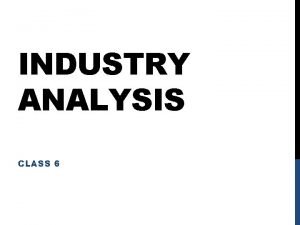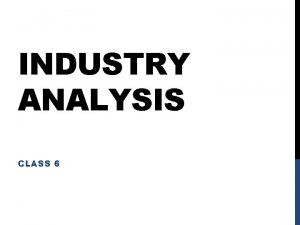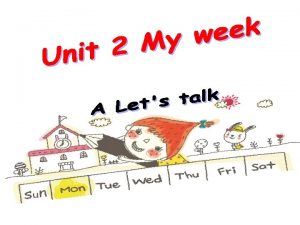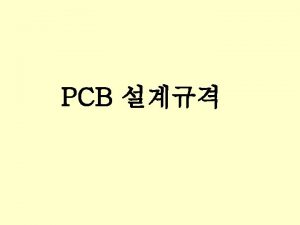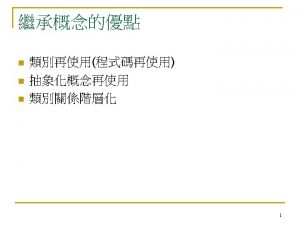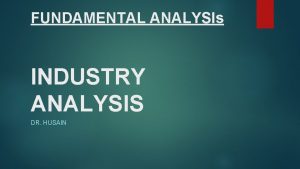INDUSTRY ANALYSIS CLASS 6 INDUSTRY ANALYSIS Industry Analysis










- Slides: 10

INDUSTRY ANALYSIS CLASS 6

INDUSTRY ANALYSIS Industry Analysis Frameworks 1. Porters Five Forces 2. Brandernberger and Nalebuff’s Value Net Given the breadth of material covered thus far we might lose track of the key insights that we have developed. The above frameworks help us systematically work through these complex economic issues. An industry analysis facilitates the following important tasks. 1. Assessment of industry and firm performance. 2. Identification of key factors affecting performance in vertical trading relationships and horizontal competitive relationships 3. Determination of how changed in the business environment may affect performance. 4. Identification of SWOT – Strengths, Weaknesses, Opportunities, Threats

PERFORMING A 5 FORCES ANALYSIS The five forces are • Internal Rivalry • Entry • Substitute and complementary products • Supplier Power • Buyer Power

INTERNAL RIVALRY Internal rivalry refers to the jockeying for share by firms within a market. * Therefore, an analysis of internal rivalry must begin by defining the market. Firms may compete on both price and non price dimensions Price – Firms will only reduce prices if they feel that they believe that they can increase market share by doing so. Non Price – This element erodes profits by driving up fixed costs (New product development) and marginal costs (Adding new product features).

THE CONDITIONS THAT TEND TO HEAT UP PRICE COMPETITION • There are many sellers in the market. • The industry is stagnant or declining. • Firms have different costs. • Some firms have excess capacity. • Products are undifferentiated and buyers have low switching costs. • Prices and terms of sales are unobservable/ prices cannot be adjusted quickly. • There are large infrequent sales orders. • Industry does not have a history of cooperative pricing. • There are strong exit barriers.

ENTRY Entry erodes incumbents profits in two ways 1. Entrants divide market demand among more sellers 2. Entrants decrease market concentration The following tend to affect the threat of entry • Production entails significant economies of sale • Government Protection • Consumers are brand loyal • Entrants have access to key inputs, technological know how, raw materials etc. • Experience Curve • Network externalities • How strong are the incumbents.

SUBSTITUTIONS AND COMPLEMENTS Substitutes erode profits – think about Skype, Viber, Whatsapp competing with local cellular companies Complements boost demand – think about games like Angry birds boosting demand for smart phones. Factors to consider when assessing this section 1. Availability of close substitutes and or complements 2. Price Value characteristics of substitutes and complements 3. Price Elasticity of demand

SUPPLIER POWER AND BUYER POWER 1. Can a supplier that has a lot of market power be beneficial to a company? Give examples 2. What is the difference between upstream and downstream. Are Suppliers upstream or down stream? Are buyers upstream or down stream? 3. What is the impact of relationships to supplier power and buyer power? 4. What is price discrimination? When can suppliers price discriminate?

WEAKNESSES OF THE FIVE FORCE MODEL • It does not pay much attention to factors that might affect demand. • It focuses on an entire industry as opposed to individual firms that might occupy niche positions that might insulate them from some competitive forces. • Governments are generally ignored in this model. • Five forces analysis is qualitative. For example analysis may say threat of entry is high, but the framework does not show to estimate the cost of entry.

VALUE NET Five forces talks about how Suppliers, Distributors and Competitors might destroy profits. Value net talks about how suppliers, distributors and competitors can enhance profits. Competition Cooperation
 Are we having class today
Are we having class today Package mypackage; class first { /* class body */ }
Package mypackage; class first { /* class body */ } Abstract class vs concrete class
Abstract class vs concrete class Lower class boundary of modal class
Lower class boundary of modal class Class i vs class ii mhc
Class i vs class ii mhc Difference between abstract class and concrete class
Difference between abstract class and concrete class Frequency distribution table grouped data
Frequency distribution table grouped data Stimuli vs stimulus
Stimuli vs stimulus Discrimination training
Discrimination training 7 rights of medication administration in order
7 rights of medication administration in order Class maths student student1 class student string name
Class maths student student1 class student string name












